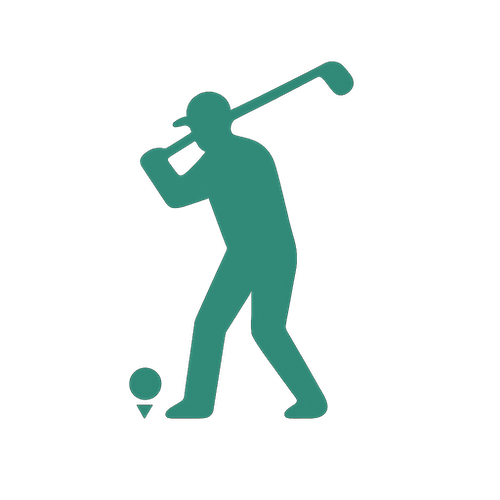Common Beginner Golf Mistakes and How to Fix Them
Embracing the Learning Curve in Golf
Every great golfer, from club champions to tour professionals, started out by making mistakes. Those topped shots, wild slices, and missed putts are not failures. They are feedback, showing you exactly what to work on next. Embracing this process is the first step toward improvement. The most common golf mistakes for beginners usually stem from just a few core areas: your grip, your stance, your swing rhythm, and your on-course decisions.
Think of these as the foundational pillars of your game. By understanding and refining them, you build a solid base for every shot you take. This approach transforms frustration into focus, helping you build confidence and truly enjoy the journey of learning how to play golf. It all starts with accepting that the learning curve is part of the game.
Getting a Handle on Your Grip
One of the first places beginners go wrong is with their grip. We often see a ‘death grip’, where the club is held so tightly that the knuckles turn white. This tension travels up your arms and into your shoulders, restricting your swing and causing inconsistent shots. The other common issue is incorrect hand placement, which leaves the clubface open or closed at impact. A proper golf grip for beginners is relaxed yet secure, allowing you to control the club without fighting it.
Here is how to build a neutral grip:
- Place your top hand: For a right-handed player, this is your left hand. Place it on the club so the grip runs diagonally across your fingers, from the base of your index finger to the pad of your palm.
- Position your thumb: Your thumb should rest just slightly to the right of the centre of the shaft. The ‘V’ formed by your thumb and index finger should point toward your right shoulder.
- Add your bottom hand: Bring your right hand to the club, interlocking your right pinky with your left index finger, overlapping it, or using a ten-finger grip. The choice is about comfort.
- Check the second ‘V’: The ‘V’ on your right hand should also point toward your right shoulder, mirroring your top hand.
For pressure, imagine you are holding a tube of toothpaste. You want to hold it firmly enough not to drop it, but not so tight that you squeeze any out. As leading publications like Golf Digest emphasize, a relaxed, neutral grip is fundamental for control and fluidity. Practice this at home to build muscle memory without the pressure of hitting a ball.
Finding Your Footing and Aim
Once your grip is set, your next focus is your setup. Many beginners stand too stiffly, as if they are at attention, or they hunch over the ball. Both postures kill your ability to rotate. Another frequent error is putting weight on the heels or toes, which causes imbalance. Finally, a huge mistake is aiming your body at the target instead of your clubface. This almost guarantees the ball will fly somewhere else.
A proper golf stance for beginners is athletic and balanced. Your feet should be about shoulder-width apart for an iron shot, with a slight bend in your knees. Tilt forward from your hips, not your waist, letting your arms hang naturally. To fix your aim, use the ‘train tracks’ analogy. Imagine one track is the line from your clubface to the target. The second track, parallel to the first, is the line your feet, hips, and shoulders are on. Your body aims parallel to the target, not at it. Even professionals constantly check their fundamentals, a practice often highlighted by instructional content from the PGA Tour, because a solid setup is the foundation of a good shot.
| Element | Common Beginner Mistake | Correct Technique |
|---|---|---|
| Posture | Standing too upright or too hunched over | Slight bend in the knees, tilt from the hips |
| Foot Position | Feet too close together or too wide | Feet shoulder-width apart for irons |
| Weight Distribution | Weight on heels or toes | Balanced over the balls of your feet |
| Alignment | Aiming body at the target | Clubface aims at target; body parallel to target line |
Mastering a Smooth Swing Tempo
The natural urge for a beginner is to hit the ball as hard as possible. This leads to a fast, jerky swing that feels powerful but actually robs you of both distance and control. Power in golf comes from sequence and rhythm, not brute force. Think of your swing not as a hit, but as a smooth, continuous motion, like a pendulum on a grandfather clock. It swings back and through at the same consistent pace.
One of the most effective beginner golf swing tips for finding this rhythm is the ‘feet-together’ drill. Stand with your feet touching and take some practice swings. This awkward stance forces you to stay balanced and use your body’s rotation to generate speed, not just your arms. You simply cannot swing too hard without falling over. A good tempo should feel consistent whether you are hitting a short wedge or a long driver. The length of your swing will change, but the rhythm should not. Remember, smoothness creates speed and control.
Playing Smarter on the Course
Fixing your technique is only half the battle. The other half is won with your brain. Many beginners make the game harder by making poor decisions. They pull out the driver on every long hole, aim directly at a pin tucked behind a bunker, or try to hit a miracle shot out of deep trouble. These ‘hero shots’ rarely work and often lead to double or triple bogeys.
Strategic golf is about playing the percentages. The goal is to get the ball in the hole in the fewest strokes, not to hit the most spectacular shot. Before every swing, identify the hazards like water, sand, or trees. Then, ask yourself: “What is the safest play that moves me forward?” Sometimes that means aiming for the middle of the green instead of the flag, or using an iron off the tee for more control. This approach reduces penalty strokes and makes the game far less frustrating. Smart decisions also help you avoid difficult situations that can force a flawed swing, which is an indirect way of learning how to fix golf slice issues before they even start.
Your Path to Confident Golfing
Learning golf is a process of building good habits. By focusing on a relaxed grip, a balanced stance, a smooth tempo, and smart on-course decisions, you are creating a foundation for a lifetime of enjoyment. Do not try to fix everything at once. Pick one thing to work on during your next practice session. Maybe it is just feeling the correct grip pressure, or using alignment sticks to check your aim.
Celebrate the small victories, like a purely struck iron shot or a well-played hole. Remember that golf is a journey of progress, not a destination of perfection. With patience and the right focus, you will see steady improvement. We are here to support you every step of the way as you learn how to play golf and build the confidence to get out on the course and have fun.









